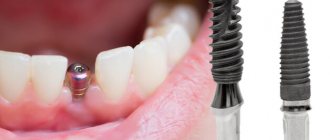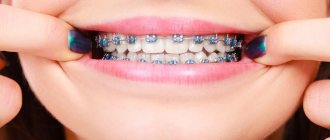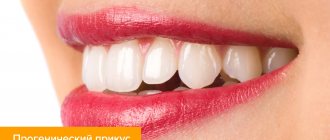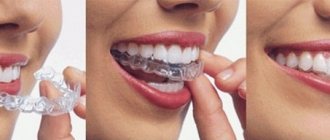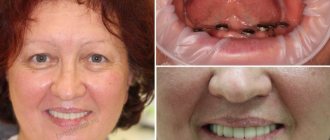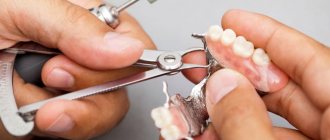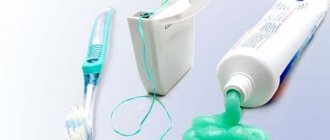Sooner or later, almost all people face the need to have dental prosthetics. Of course, it would be better if such a moment came as late as possible, but if problems with the dentition have arisen, they need to be resolved quickly so as not to cause irreparable harm to one’s own health. What dentures are best to put in if it’s time to “surrender” to the hands of an orthopedic dentist? To make a good choice, you need to know what dentures are in general and in what cases they are usually used.
What is an end defect?
Losing the attractiveness and integrity of a smile is a real disaster for most people. But, unfortunately, there are people for whom the loss of a tooth or even teeth is absolutely no reason to see a dentist. Especially when it comes to back molars.
Loss of the back teeth of the upper or lower jaw is called an end defect
– and this is truly one of the most important and complex problems in prosthetic dentistry. First of all, due to the enormous functional load that the posterior (chewing) teeth bear.
“Just think, my back teeth are falling out! You still can’t see them when you smile!”
Of course, this is a misconception. After all, the point is far from being about the beauty of a smile, but about a functional disorder of the dental system, which provokes many serious dental diseases. The absence of back teeth will sooner or later trigger a process of negative consequences in relation to both the central teeth and the smile line.
Aesthetic consequences
The presence of even one gap in the dentition can change the proportions of the face over time. Age-related aging processes accelerate, become more noticeable, and intensify:
- due to alveolar bone resorption, facial height decreases;
- vertical lines become more noticeable in the area of the lips and chin, making the face look rougher;
- The bite gradually changes, which can cause the proportions of the lips to be disrupted and the chin to change;
- with edentulism in the upper jaw, the nasolabial groove deepens faster and more noticeably, which is why the face looks older;
- It is possible to form a double chin if the attachment of the muscles to the body of the lower jaw is disrupted and their tone decreases.
What is the danger of losing chewing teeth?
If there is an end defect on at least one side (not to mention two at once), it will immediately become noticeable. When a person chews food on only one side for a long time, the load on it instantly increases, and the temporomandibular joint is overloaded. Ultimately this leads to:
- problems with chewing food;
- problems with the digestive tract arising from the previous paragraph;
- displacement of teeth in the oral cavity and their falling out of their sockets - there are no “antagonist” teeth that would distribute the load;
- reduction in bone tissue volume;
- facial asymmetry (sunken cheeks, deep nasolabial folds, malocclusion);
- frequent headaches;
- rapid wear of teeth adjacent to the chewing teeth, or chewing teeth on the opposite side.
Don’t delay with dental prosthetics
Whatever the reason for delaying prosthetics, we urge you :
Don't miss the opportunity to live a healthy and fulfilling life!
Sign up for a consultation with an orthopedic dentist by phone or on the website >>
Share the link:
- Click here to share content on Facebook. (Opens in a new window)
- Click to share on WhatsApp (Opens in new window)
implantation, orthopedics, articles, surgery topics: bone atrophy, implantation, bone grafting, fixed prosthetics, covering prostheses, prosthetics, prosthetics on implants, removable prosthetics
Causes of loss of back teeth
The most common cases of loss of chewing teeth are neglected and untreated dental diseases: caries
, which developed into
pulpitis
or periodontitis, due to which the tooth had to be removed.
In addition, teeth (any teeth, including chewing ones) can fall out due to gum disease - periodontitis
or
periodontal disease
- in both diseases, the roots of the teeth become loose and do not hold in the inflamed gums.
Hormonal (for example, during pregnancy) or age-related changes also often lead to tooth loss.
Chewing teeth can also fall out due to prolonged wearing of bridges. When installed, such dentures are attached to adjacent teeth (most often to the posterior chewing teeth), and over a long period of wear they become loose. That is why bridge structures in modern dentistry are increasingly giving way to more advanced types of tooth replacement.
In the rarest cases, an end defect occurs in children at birth - when the rudiments of the back teeth were not formed at the stage of formation of the skeletal system. This happens mainly due to hereditary factors. You should also monitor your child’s primary chewing teeth – their premature loss can lead to the loss of the back molars.
One way or another, any lost tooth must be replaced as soon as possible, and the first step in this will be a timely visit to an orthopedic doctor.
On a note!
Currently, in As-Stom dentistry there is
a 15% discount
on all dentures and
a 50% discount
on an implant with installation. Both dentures and implants are excellent options for replacing lost back teeth.
How many implants are needed?
Possible options:
- 2 classic (two-piece) implants are implanted along the edges of the defect, after healing they are loaded with a permanent prosthesis of 3 connected crowns (2 “sit” on the implants at the edges, 1 in the middle fills the void);
- 3 classic (two-piece) implants replace missing teeth with individual implants and load them with separate crowns after implantation of artificial roots;
- 3-4 monoblock (one-stage) implants on titanium roots immediately fix an adaptive prosthesis with a titanium arch and three welded crowns.
The choice of the number of implants depends on the location of the defect.
Which ones are better for chewing teeth?
Implantation of chewing teeth
– the most effective and reliable recovery option. An implant is an artificial root that will take on the entire load when chewing, will not become loose, will not fall out, and will not lead to the loss of neighboring teeth. Implants are long-lasting, you can install a durable metal-ceramic crown on them, and even after the service life of the prosthesis expires, the implant does not need to be replaced.
However, implantation of back teeth may become impossible if a large amount of time has passed since the loss, due to loss of bone tissue. It is possible to perform bone augmentation surgery (sinus lift), but this will significantly increase the time and cost of implantation. In addition, even a sinus lift is not possible in all cases, and each case must be considered individually.
Removable prosthetics
- the simplest and most accessible method. Both soft nylon dentures and plate removable dentures can be used as removable dentures.
Nylon prosthesis
feels more comfortable in the mouth; in case of a terminal defect, it can be attached both to adjacent teeth and to the gum. However, such a prosthesis lasts for a maximum of 5-7 years, and towards the end of its service life it begins to fit worse in the mouth, which is why the patient will need to use additional fixing creams and ointments.
Lamellar prosthesis
(plastic, acrylic or acry-free) - cheaper and more accessible than nylon, but hard and less comfortable in the mouth.
Clasp prosthetics
(in which the prosthesis will be attached to adjacent teeth with hooks or clasps) is possible only in the case of an end defect on both sides of the dentition. This is a more comfortable method of conditionally removable prosthetics, convenient, evenly distributing the load and securely fixed to the teeth. However, if we talk about the loss of chewing teeth, such a prosthesis will have to be attached to the supporting front teeth, which means that the hooks can be noticeable when smiling and talking, which reduces the aesthetics of such a prosthesis. If you take clasp dentures with clasps, you will have to grind down the patient’s neighboring, healthy and intact teeth for fastening, put crowns on them, and only attach clasps to these crowns.
As a result, the most reliable, effective and, ultimately, profitable method of restoring chewing teeth is implant prosthetics. Taking into account the variety of implants
, you can choose an option that suits the patient both in price and quality.
However, each case must be considered individually. An orthopedic specialist will determine possible options for prosthetics of a chewing tooth to make your smile full and attractive. Each specific situation has a specific prosthetic plan.
You can make an appointment at the As-Stom clinic by phone 597-05-05
or using the online application form on the website.
Restoration of molars – defect included
An included defect means that there are living teeth on either side of the defect. In this case, the recovery options available to the patient are:
- Removable dentures
- Implantation
- Fixed prostheses (bridges)
A bridge can be used to restore molars if the defect extends to 1-2 missing teeth. In some cases, orthopedists can use a bridge of three artificial teeth, but this depends on the individual clinical picture.
Prosthetic bridges for molars are made from various materials. So, to restore the chewing area, they most often choose:
- Metal-ceramics - the basis of artificial teeth made of metal, on top - an aesthetic ceramic veneer. This is a popular and widespread option due to its affordability.
- Zirconium is the choice of patients who are focused on premium prosthetics. In such an orthopedic design, the base is made of zirconium dioxide. The top part is ceramic.
All-ceramic dentures for the chewing zone are not used due to their relatively low strength indicators.
What is secondary edentia
Why, with partial edentia, teeth cannot fully perform the chewing function?
What does partial adentia lead to?
In dental practice, a situation often occurs when a patient is missing several teeth and one could say that this is partial adentia, BUT the remaining teeth are in such a deplorable condition that they cannot perform their natural functions, and in this case it would also be complete edentia, i.e. lack of teeth for chewing food.
On the picture
- partial edentia
Prohibition on instant implantation
In some cases, immediate implantation is not possible. This primarily applies to patients with atrophied bone tissue, in which case a lengthy process of osteoplasty will be required before surgery. It will also be impossible to implant a pin if there are fistulas, ulcers, cysts and other formations in the oral cavity. A painful condition of the mucous membrane or tongue is also a temporary contraindication.
Implantation is prohibited even if a person has such serious diseases as oncology, diabetes, vascular and heart disorders, problems with the thyroid gland and immune system, tuberculosis, HIV, diseases of the circulatory system, allergies to the materials and drugs used, mental disorders , prolonged depression, etc.
In rare cases, it happens that the doctor was ready for immediate implantation, but during the course of work the situation changes. As a result, implantation has to be delayed for several weeks until the soft tissues have healed after tooth extraction.
Plate complete removable denture
The design of a complete removable denture of the lower jaw consists of a base - an acrylic or plastic plate shaped like a jaw with artificial teeth. It is attached directly to the lower jaw itself, while a removable denture for the upper jaw is usually attached to the roof of the mouth.
The inserted lower jaw is well fixed on the gum due to its suction ability, which allows you to keep the prosthesis in the desired position without the use of any additional clamps.
Indications for the use of complete removable prosthetics of the lower jaw teeth:
- Lack of supporting teeth on which fixed dentures can be attached;
- Tendency to allergic reactions that occur upon contact with metals;
- Immune diseases;
- Reduced blood clotting;
- Oncological diseases;
- Diabetes mellitus and cardiovascular diseases;
- Unresponsiveness and intolerance to anesthesia;
- Short-term use during the period of adaptation of the body after installation of implants.
The method of prosthetics on implants is more reliable, convenient to use and durable. In addition, this method does not require additional care.
Impaired dental aesthetics and psychological problems
The natural beauty of a smile is disrupted not only by the absence of a front tooth. As practice shows, a lost lower “six” or “seven” will cause malocclusion and can lead to degradation of bone tissue both at the site of the gap formed and in the area of the upper incisors.
Thinning of the epithelial layer will lead to gum recession - the formation of a deep cavity that exposes the root of the tooth. This is a significant aesthetic flaw that makes women and men feel awkward when communicating with people. Quite often, such a defect causes a decrease in self-esteem. Many patients develop a psychological complex that negatively affects their quality of life.
